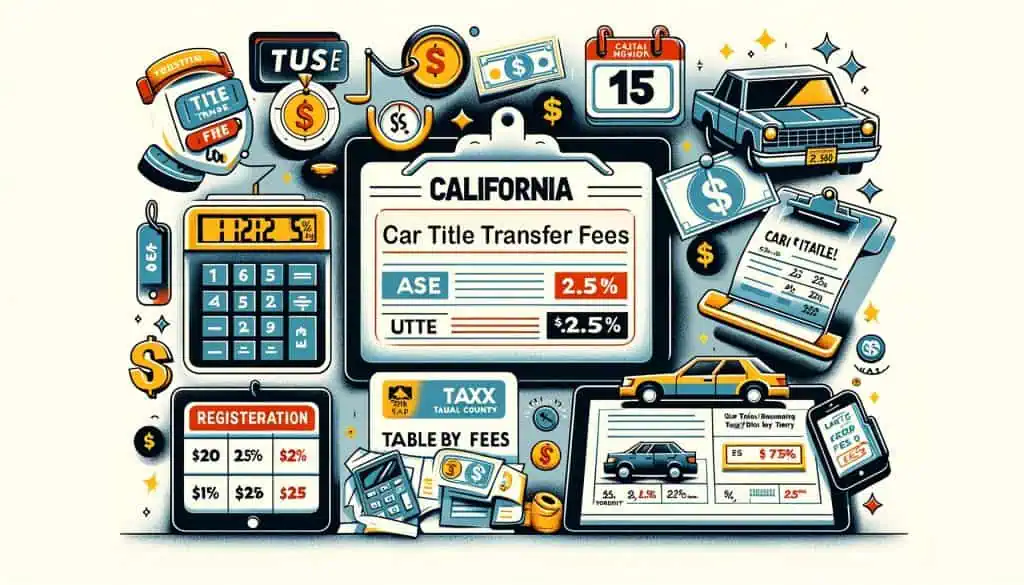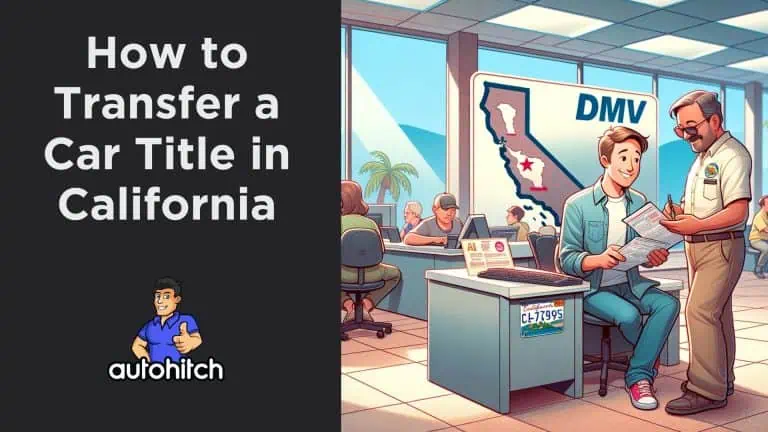Wondering how to officially change ownership when buying, selling, or inheriting a car in California?
Transferring a title is required by the CA DMV, but as with most government agencies in California, the process can be confusing if you’ve never done it before.
As a former car dealer, I’ve researched the process, and I’ll walk you through the essential steps, documents, and costs to smooth your California vehicle title transfer.
Helpful Links For Transferring A title in California:
- California DMV
- Calculate My Fees To Transfer Title
- California DMV Online Services
- California DMV Appointments
- Fillable CA DMV Title Transfer Forms
- Vehicle/Vessel Transfer Form REG 262
Table of Contents
California Car Title Transfers: Quick Visual Guide
This reference table outlines key steps, documents, and tips to smoothly transfer vehicle ownership in California.
| Action Item | Description |
|---|---|
| 💡 When Needed | Buying, selling, inheriting a car, gifted cars |
| 📃 Gather Documents | California title, REG 227 form, bill of sale, odometer statement |
| ✍️ Complete Paperwork | Fill out all DMV title transfer forms fully and accurately |
| 💵 Pay Fees | $15 transfer fee plus use tax on vehicle price |
| 🏢 File at DMV | Bring signed forms to DMV office OR mail to Sacramento address |
| ⏳ Process Time | New title mail out in 15-30 days usually |
| 📝 Seller – File Notice | File a Notice of Release of Liability online |
| 💡 Helpful Tips | Double check form accuracy to avoid delays |
You might also need to read:
- How to Transfer a Car Title to a Family Member in California
- How To Transfer A Car Title Out Of A Trust
- Can I Sell My Car Without a Title
- How Long Does A Smog Certificate Last
When Do You Need to Transfer a Car Title in California?
A few common situations that require a title transfer in California include:
- Purchasing a Vehicle: The title must move from the seller to the buyer. This goes for private party and dealership purchases.
- Selling Your Car: As a seller, you’ll need to sign over the title to the new owner.
- Inheriting a Car: Inheritors will need to transfer the title from the deceased into their name.
- Gifted Cars: Even vehicle gifts from friends or family require officially updating the title.
Bottom line – the CA DMV legally mandates a title transfer whenever vehicle ownership changes, even between relatives.
Key Documents You’ll Need to Transfer a California Car Title
Before heading to the DMV, ensure you have the right documents in hand. Missing papers can delay the process by weeks or even months.
The core title transfer documents are:
- California Certificate of Title: Proof of current legal ownership with owner signatures releasing interest.
- Application for Title Transfer (REG 227): If no title, this form establishes ownership transfer.
- Bill of Sale: Records sale details like price/date for DMV reference.
- Odometer Disclosure: For vehicles under 10 years old.
Additionally, you may need to provide supporting documents like:
- Emissions Test Certificate: Also called a “Smog Check”, it’s generally required in CA urban areas. Under 4 years old often exempted.
- Release of Lien: If financing just paid off, shows bank released their ownership claim.
- Inheritance Documentation: For inherited vehicles, includes will or estate letters authorizing ownership transfer.
Review the DMV’s full list of title transfer forms to see if any apply to your specific situation.

Step-by-Step Guide to Transfers in California
Follow these key steps when transferring ownership:
1. Collect Required Documents
Gather documents like the current title, bill of sale, or odometer reading to establish proof of transfer. Review the DMV’s documentation checklist to ensure you didn’t miss anything vital.
2. Complete Title Transfer Paperwork
Fill out and sign any required paperwork such as the REG 227 or REG 262. Ensure all buyer, seller, and lienholder information is accurate and signatures are complete.
3. File Notice of Release Liability
If selling, file an online Notice of Transfer and Release Liability within 5 days. This protects the seller from legal responsibility after ownership changes.
4. Submit Documents & Payment In-Person or By Mail

Bring signed documents, applicable forms, and transfer fees to your local DMV office OR mail to:
Department of Motor Vehicles
PO Box 942869
Sacramento, CA 94269-0001
Payment can be made by check or money order if sent by mail.
5. Receive New Car Title
Once everything is processed, the new title establishing updated ownership will be mailed out in 15-30 days. Vehicle registration will also be updated.
What Are California Car Title Transfer Fees?
Expect to pay the main state transfer filing fee, plus potentially other costs like:

- Title Transfer Fee: $15 base price to transfer ownership.
- Use Tax Fee: 2.25% – 2.5% of sales price. Tax table by county is available here.
- Registration/Permit Fees: Varies based on vehicle age, price, and county.
- Late Fees: Up to $25 if not transferred within 10 days of sale.
Use the DMV’s registration fee calculator for a personalized estimate based on your car and county.
Tips for Streamlining California Title Transfers
Consider these tips to save time and avoid hassles when transferring vehicle ownership in California:
- Sellers: Note exact sale date and odometer reading on paperwork to align with buyer’s records.
- Buyers: Carefully enter ownership details on paperwork and triple check for errors to prevent delays.
- Out-of-State: Apply for a California title at local DMV office within 20 days of becoming a CA resident.
- Online Services: Request replacements and start applications online via the DMV’s Virtual Office. But expect to still file signed paperwork by mail.
- Private Services: Let an established private DMV service handle complex title transfers for you, for an extra fee.
Transferring a California Car Title Out-of-State
Are you moving out of California and taking your vehicle with you? Here are the key steps to transfer and register an existing CA title in another state:

1. Prepare the Title Transfer Paperwork
You’ll need either the current California title or an Application for Replacement/Transfer of Title form (REG 227) signed by owners and lienholders releasing interest.
2. Complete DMV Forms
Fill out a Report of Sale–Used Vehicle form (REG 51), marking it’s “for registration in another state”. Also submit a Statement of Facts form (REG 256) recording the out-of-state move.
3. Notify California DMV Within 10 Days
Report your change of address and new state residency to the CA DMV. This ensures future mail and renewals stop.
4. Pay Applicable Fees
A standard $15 transfer fee must be included with your title paperwork.
5. Register Your Vehicle in the New State
Finally, follow the new state’s vehicle import and registration rules. Carry your signed CA title paperwork confirming you completed California’s title transfer process.
Key Takeaways – California Title Transfers
Transferring a vehicle title in California takes a few simple steps if you prepare properly. Be sure to:
- Complete all DMV title forms accurately
- Have required documents like signed title, bill of sale, or odometer statement
- Pay applicable transfer and use tax fees
- Mail paperwork or drop off at DMV office
- Sellers file a Notice of Release of Liability online
Following this DMV guide carefully lets you change ownership smoothly as a buyer or seller in the Golden State. Reach out to a private filing service if you need hands-on help navigating the title transfer process.
Sources For This Guide:
- https://www.dmv.ca.gov/portal/vehicle-registration/titles/title-transfers-and-changes/
- https://www.dmv.ca.gov/portal/dmv-virtual-office/title-transfers/
- https://sandiegomagazine.com/guides/how-to-transfer-a-vehicle-title-online-in-california/
- https://www.etags.com/blog/title-transfer-fee-california/



